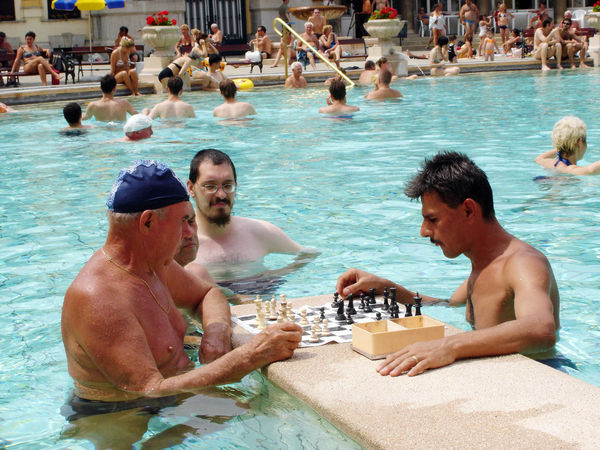Soak in Opulence at Budapest’s Thermal Baths
By Rick Steves

Centuries ago, the towns of Buda and Pest, the leading cities of a mighty Hungarian kingdom, united to become Budapest. Today, Hungary's vibrant capital maintains its stately ambience and offers plenty of tourist-friendly activities. You can sample spicy paprika at the Great Market Hall (designed by Gustave Eiffel), sip coffee in a sumptuous turn-of-the-20th-century café, and enjoy an affordable performance at the luxurious Opera House. Budapest has its fair share of museums and monuments, too: You can gape at the implausibly lavish interior of the Hungarian Parliament, get a taste of the gloomy Hungarian psyche at the National Gallery, and wander through a field of giant communist statues at Memento Park.
But for me, splashing and relaxing in Budapest's thermal baths is the city's top experience. Though it might sound daunting, bathing in Budapest is far more accessible than you'd think. Tourists are welcome. The thermal baths are basically like your hometown swimming pool — except the water is around 100 degrees, there are plenty of jets and bubbles to massage away your stress, and you're surrounded by Hungarians having fun.
Locals brag that if you poke a hole in the ground anywhere in Hungary, you'll find a hot-water spring. Judging from Budapest, they may be right: The city has 123 natural springs and some two-dozen thermal baths. The baths are actually a part of the health-care system. Doctors regularly prescribe treatments that include massage, soaking in baths of various heat and mineral compositions, and swimming laps. For these patients, a visit to the bath is subsidized.
In Hungary, a typical bath complex has multiple pools, used for different purposes. Big pools with cooler water are for serious swimming, while the smaller, hotter thermal baths are for relaxing, enjoying the jets and current pools, and playing chess. You'll also usually find a dry sauna, a wet steam room, a cold plunge pool (for a pleasurable jolt when you're feeling overheated), and sunbathing areas. Many baths have fun flourishes: bubbles, whirlpools, massage jets, wave pools, and so on. Expect to pay around $30 for admission and a personal changing cabin (a bit cheaper if you change in the locker room). Swimsuits are the norm; nudity is rare.
Two of Budapest's baths — Széchenyi and Gellért — are the best known, most representative, and most convenient for first-timers.
To soak with the locals, head for the Szechényi bath complex — a big, yellow, copper-domed building in the middle of Budapest's City Park. Recent renovation has restored the complex to its late-19th-century glory days, making Széchenyi Budapest's best bath.
The seemingly confusing entry procedure is like a time-warp back to communist bureaucracy...but that's all part of the experience, and somehow, it works.
Here's how my recent visit to the Széchenyi Baths went: I entered the elegant spa, bought my entry ticket and towel (I should have thought ahead and borrowed one from my hotel), grabbed my waterproof wristband, and headed through the turnstile. I was immediately lost in a labyrinth of hallways, until a white-smocked bath attendant pointed me toward the locker room. After I slipped into my swimsuit, I was finally ready for some hot-water fun.
Sitting in hundred-degree water under glorious Baroque domes, I felt my stress ebb away as I enjoyed some of Europe's most memorable people-watching. Hungarians of all shapes and sizes were stuffed into tiny swimsuits, strutting their stuff. People floated blissfully in warm water. Speedo-clad intellectuals stood in chest-high water around chessboards and pondered their next moves. It's Budapest at its best.
Afterward, completely relaxed, I changed back into my street clothes, gave my soggy swimsuit a spin in the centrifuge, and dropped off my wristband as I floated through the turnstile.
Budapest's more atmospheric option is the Gellért Baths, located in a fancy hotel. Gellért is more sedate and luxurious than Szechényi — with exquisite porcelain details and an air of mystery. And in the summer, the Gellért Baths have something Széchenyi doesn't: a huge, deliriously enjoyable wave pool that'll toss you around like a surfer.
While Hungary has several mostly nude, segregated Turkish baths, Szechényi and Gellért are less intimidating: Men and women are usually together, and you'll keep your swimsuit on the entire time. But even at these baths, there are a few clothing-optional areas, where locals are likely to be nude or wearing only a koteny (a loose-fitting loincloth).
With or without your Speedo, take the plunge. My readers often report that the thermal baths were their top Hungarian experience. If you go into it with an easygoing attitude and a sense of humor, you'll never forget bath time in Budapest.

